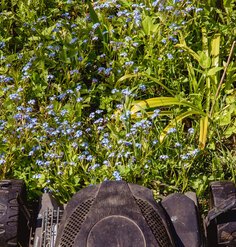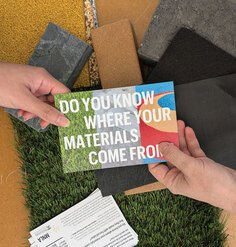From the Field: The Cal Poly Pomona CSI Team's Dead End with Property Values
By Barry Lehrman, Assistant Professor and Mallory Piazolla, MLA Candidate, California State Polytechnic University Pomona
The West San Gabriel River Parkway Nature Trail in Lakewood, California is a remarkable transformation of 19.5-acres of gopher-ridden, dusty and weedy powerline right-of-way into a verdant native floodplain ecosystem in a stable working-class suburban community. Situated on the western concrete bank of the 58-mile long San Gabriel River in southern Los Angeles County, the Nature Trail is the first project to realize the goals of the 2006 San Gabriel River Corridor Master Plan and features a reclaimed water irrigation system, native vegetation, and 5,000 linear feet of decomposed granite trails.
Prior to the construction of the Nature Trail, several property owners had illegally encroached onto the right-of-way with fences and landscape plantings, necessitating an involved public outreach effort led by MIG. On a May site visit, we observed that many adjacent property owners had built new fences and added gates to access the trail, visibly demonstrating the value of proximity. We wondered if we could document the economic benefits of the conversion of the right-of-way into a nature trail. Even if we couldn’t prove an increase in economic value, there was plenty of anecdotal evidence that the social value of the neighborhood was up thanks to the new trail and vegetation.
Hypothesis: The Nature Trail increases adjacent property values compared to the unimproved powerline right-of-way.
Since the trail is being built in three phases (Phase I was completed in 2003, Phase II opened in 2007, and Phase III is still awaiting funding), the undeveloped Phase III would be an ideal control subject for our analysis.
Methodology
Data on residential property values for the streets adjacent to the three phases of the West San Gabriel Greenway Nature Trail were collected from Zillow.com, providing usable information for about 26 properties: 14 from Phase I, 5 from Phase II and 7 from Phase III. Los Angeles County Assessor data was reviewed but not used for our analysis as their assessed values are out-of-date and notoriously do not reflect current market conditions. To compare the properties, the cost per square foot for each property was calculated based on the Zillow.com estimate (Zestimate) of the current property value. This value was chosen to reduce variations caused by market fluctuations and when the homes were last sold. An ANOVA analysis comparing the cost per square foot values of the three phases was run using StatPlus.
Conclusion and Discussion
The West San Gabriel River Nature Trail does not provide a statistically significant increase in property valuation when comparing Phases I and II to the unimproved Phase III. A false negative finding might be attributed to several factors: our crude means of analysis, the small dataset (n=26), or the raw data from Zillow since Zillow may calculate home prices based on data from a wider neighborhood that obscures block-by-block variations in home prices that we sought to identify.
A more sophisticated analysis (using hedonic regression) with a larger sample that controls for the fluctuating housing market/macroeconomic conditions, or that uses longitudinal data over the past decade or longer may still yet validate our hypothesis. Another possibility is that property value increases will emerge in the future as the Nature Trail’s landscape matures and people who place a premium on access to the trail seek to move into the neighborhood.
The staff from the City of Lakewood embraced this last possibility on our August 2 site visit. They observed that there is an ongoing demographic shift from the original homeowners who bought houses in the 1960s and 70s to an influx of younger (and more active) families. We discussed conducting a survey of the neighborhood asking about perceived values for the Greenway. The city may undertake such a survey in the future if there are specific uses for the results that justify the effort and expense.
There is a large body of research on the economic benefits provided by parks and landscape amenities. The theory of Landscape Urbanism is even based on this premise — that Central Park in New York City generated the intense urban vitality of the surrounding neighborhood. It is just more difficult to prove than we anticipated.
Professor Barry Lehrman, with Graduate Research Assistants Mallory Piazzola, Edna Robidas, and Eric Haley are participating in LAF’s 2012 Case Study Investigation (CSI) program and working to quantify the landscape performance benefits at four project sites around metropolitan Los Angeles. Professor Lehrman is the director of the Los Angeles Aqueduct Centennial Project at Cal Poly Pomona. Any opinions expressed in this article belong solely to the author. Their inclusion in this article does not reflect endorsement by LAF.











